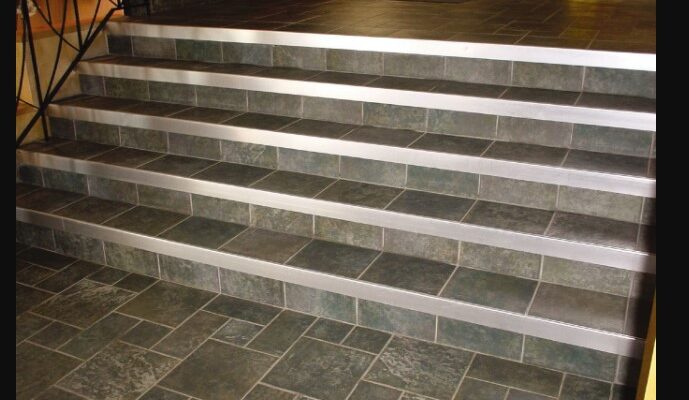Stair nosing is often overlooked when it comes to home improvement and safety. But did you know there are various types of nosing, each designed for specific needs and aesthetics?
Let’s explore the world of stair nosing and the different types available, their benefits, and how they can enhance safety and design in your home.
Contents
- 1 Introduction to Stair Nosing
- 2 Importance of Stair Nosing
- 3 Bullnose Stair Nosing
- 4 Square Stair Nosing
- 5 Round Stair Nosing
- 6 Tread Nose Stair Nosing
- 7 Half-Round Stair Nosing
- 8 Integral Stair Nosing
- 9 Anti-Slip Stair Nosing
- 10 Illuminated Stair Nosing
- 11 Metal Stair Nosing
- 12 Wood Stair Nosing
- 13 Rubber Stair Nosing
- 14 Vinyl Stair Nosing
- 15 Conclusion
- 16 FAQs
Introduction to Stair Nosing
Stair nosing refers to the front edge of the stair tread that extends beyond the riser. It serves a dual purpose: enhancing safety by providing extra foot space and protecting the edges of the stairs from wear and tear. But what exactly are the different types of nosing, and why are they important?
Importance of Stair Nosing
Stair nosing is more than just a finishing touch. It increases the surface area of each step, making stairs safer by reducing the likelihood of slips and falls.
Additionally, it helps protect the stair edges from damage, ensuring their longevity. Think of it as the safety belt for your staircase—essential for both function and peace of mind.
Bullnose Stair Nosing
Bullnose stair nosing is one of the most common types. It features a rounded edge that protrudes slightly over the riser. This design adds a smooth, elegant finish and provides additional grip, making it safer to use. Bullnose nosing is particularly popular in residential settings due to its classic look and practicality.
Square Stair Nosing
Square stair nosing has a sharp, 90-degree angle edge, giving it a modern and sleek appearance. This type of nosing is often used in contemporary and commercial settings. The clean lines of square nosing can complement minimalist and modern design styles.
Round Stair Nosing
Similar to bullnose, round stair nosing features a curved edge but with a more pronounced rounding. This type of nosing is comfortable underfoot and often used in settings where safety and comfort are priorities. Round nosing can give stairs a softer, more inviting look.
Tread Nose Stair Nosing
The tread nose stair nosing is designed to cover the entire stair tread. It provides a consistent surface from the tread to the nosing, which can help prevent tripping. This nosing type is beneficial in high-traffic areas where safety is paramount.
Half-Round Stair Nosing
Half-round stair nosing offers a compromise between square and round nosing. It features a slightly curved edge, providing both aesthetic appeal and safety. This type of nosing can be a versatile option for various architectural styles.
Integral Stair Nosing
Integral stair nosing is built into the tread, creating a seamless look. This nosing type is often found in high-end installations where a sleek, continuous appearance is desired. For visual interest, integral nosing can be made from the same material as the tread or a contrasting material.
Anti-Slip Stair Nosing
Anti-slip stair nosing is designed with safety as the primary focus. It features a textured surface that provides additional grip, reducing the risk of slipping. This nosing type is ideal for moisture-prone areas, such as outdoor stairs or commercial settings.
Illuminated Stair Nosing
Illuminated stair nosing incorporates lighting elements like LED strips to enhance visibility and safety. This nosing type is perfect for environments where low lighting, such as theaters, nightclubs, and outdoor steps, might pose a hazard.
Metal Stair Nosing
Metal stair nosing is highly durable and can withstand heavy use. Common materials include aluminum, stainless steel, and brass. Due to its strength and longevity, metal nosing is often used in commercial and industrial settings. It can also add a contemporary touch to modern interiors.
Wood Stair Nosing
Wood stair nosing provides a warm and natural look, making it a popular choice for residential settings. It can be made from various wood types, including oak, maple, and cherry. Wood nosing can be stained or finished to match the rest of the staircase.
Rubber Stair Nosing
Rubber stair nosing offers excellent slip resistance and is comfortable underfoot. It is commonly used in schools, hospitals, and other areas where safety and comfort are essential. Rubber nosing is available in various colors and can be customized for specific design needs.
Vinyl Stair Nosing
Vinyl stair nosing is a cost-effective option with good durability and slip resistance. It is available in various colors and styles, making finding a match for any decor easy. Vinyl nosing is often used in residential and commercial applications.
Conclusion
In conclusion, stair nosing is critical to any staircase, enhancing safety, durability, and aesthetics. Various nosing types are available, so you can choose the one that best fits your needs and design preferences. Whether you prioritize safety with anti-slip nosing, add elegance with bullnose nosing, or go modern with square nosing, there’s a perfect option for every staircase.
FAQs
1. What is stair nosing?
Stair nosing refers to the edge of the stair tread that extends beyond the riser, enhancing safety and aesthetics.
2. Why is stair nosing important?
Stair nosing increases safety by providing extra foot placement space, reduces stair wear, and adds a finishing touch to the stairs.
3. What are the different types of stair nosing?
Several types include bullnose, square, round, tread nose, half-round, integral, anti-slip, and illuminated nosing.
4. Which material is best for stair nosing?
The best material depends on the setting and needs. Common materials include metal, wood, rubber, and vinyl, each offering unique benefits.
5. Can I install stair nosing myself?
Yes, stair nosing can be installed as a DIY project with the right tools and skills, though professional installation ensures the best results.
If you gained new insights from this article, explore our blog, Gimkit, for more enlightening content.



